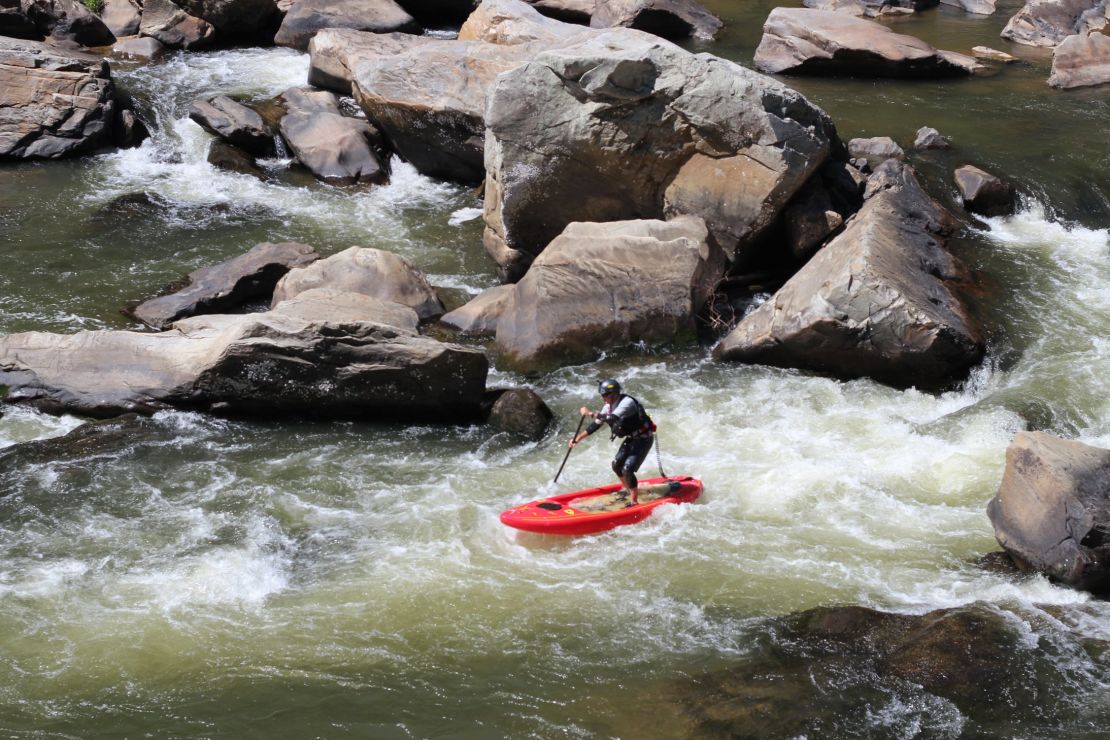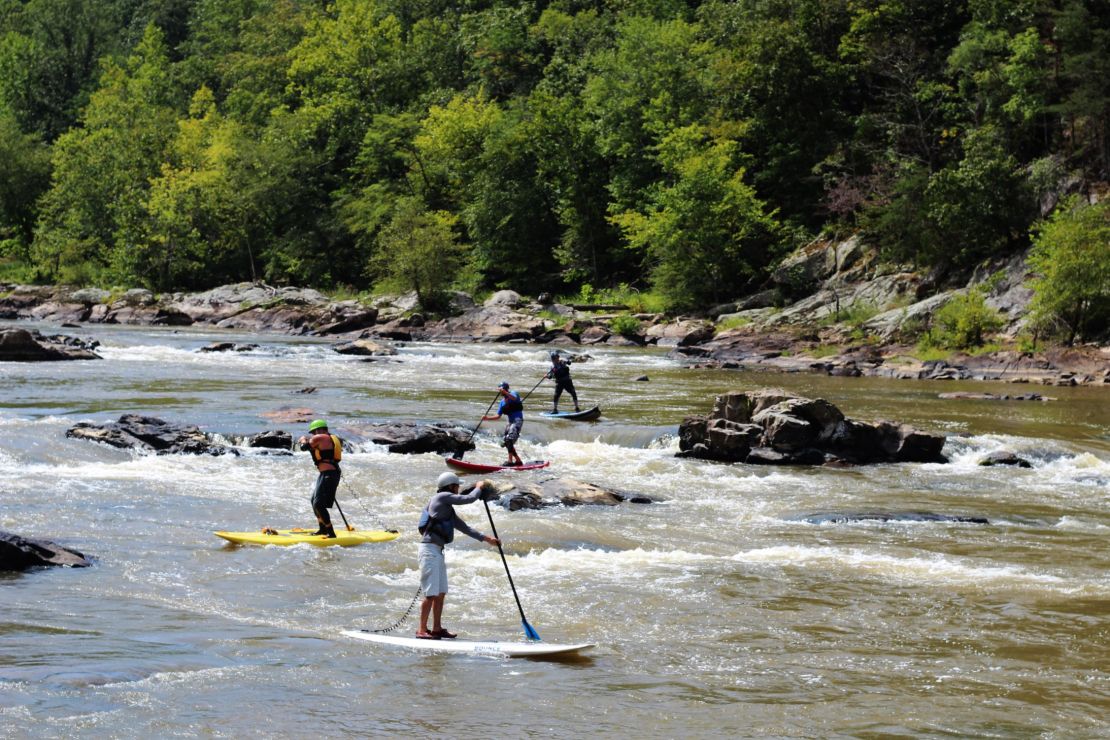Story highlights
Stand-up paddleboarders are taking to whitewater
"Let the water do all the work," one avid SUPer says
It’s not the smoothest sport, nor the most graceful.
At its most exciting moments, participants end up in kind of a slipping-on-a-banana-peel stance.
Yet for those who love it, whitewater stand-up paddleboarding – or whitewater SUPing – holds a powerful allure.
For some, it brings a big thrill with a little less risk.
That’s why paddling instructor Jack Nelson switched from kayaking to whitewater SUPing.
“I took some scary swims (in a kayak) and just thought, ‘I don’t know, if I stay with this group of guys that I’ve grown in the sport with, am I going to be one of those statistics that dies on the river?’ ” said Nelson, 31, an American Canoe Association level 3 whitewater SUPing instructor who lives in Bristol, Tennessee.
Then, Nelson started stand-up paddling on class II and III rapids, “and I was like ‘wow, this is amazing,’ plus it’s really hard. And in a kayak, that was boring.”
Now, he’s competing professionally in stand-up paddleboarding and serves as lead SUPing instructor at river outfitter USA Raft when he’s not working his day job as a high school criminal justice teacher.

Certainly, paddling rapids while standing on a board makes the easier classes of whitewater harder.
Class II and III rapids that have become ho-hum in kayaks and rafts are exciting again when you’re trying to stay on your feet amid the crash and swirl of water rushing through an only partially visible obstacle course of rocks.
So you get more SUP adrenaline on less treacherous stretches of river, armored with a helmet, a personal flotation device, river shoes and elbow and knee pads.
“We’re all still nervous when we’re running class IV and V whitewater, for sure. And, you know, that’s part of why we do it,” said Matt Moses, 45, owner of USA Raft and an avid whitewater stand-up paddleboarder.
“Personally, I enjoy class III whitewater. It’s just fun and wet and splashy, and you still have to make some moves, but you don’t feel like you’re putting it all on the line,” said Moses, whose company has a riverside location on the Nolichucky River in Erwin, Tennessee, and another outpost near the French Broad River in Marshall, North Carolina.
Stand-up paddleboarding goes wild
The whitewater SUP niche is growing, with pockets of paddlers popping up on rivers across the United States, but it’s unlikely to catch up with the nearly ubiquitous flat-water version of stand-up paddling seen on bays, lakes and calm rivers.
Only about 10% of the 1,000 stand-up paddleboarding instructors certified by the nonprofit American Canoe Association are certified for whitewater, according to association Chief Operating Officer Chris Stec, but SUP participation has skyrocketed overall since the mid-2000s, when stand-up paddleboarding arrived in the continental U.S. as a recreational sport.
In fact, it’s the fastest-growing outdoor activity in terms of participation, according to the Outdoor Industry Association (PDF). Participation increased by 38% from 2013 to 2014, following a 29% increase the previous year.
Whitewater stand-up paddleboarding enthusiast Michael Goforth, 45, calls it “walking on water.”
“I don’t know how to describe it. It’s so beautiful,” said Goforth, who was paddling with Moses and some other friends in the Nolichucky River Gorge on a perfect, cloudless 80-degree day in August.
“It can be a really passive, intuitive thing. That’s kind of what your goal is, is to let the water do all the work, and you use your paddle to assist when it’s not perfect,” said Goforth, a land surveyor who recently moved from North Carolina to Fredericktown, Missouri.
Managing risks
It’s not without its bumps, bruises and worse.
Moses, who tore a knee ligament while SUPing last year, always wears protective gear, sometimes opting for a helmet with a full face mask. He inspires a lot of comments on the river.
“People are just always like ‘Really? You just came down that rapid I fell out of this raft in? You guys are crazy!’
“So we get a lot of looks, a lot of comments,” Moses said. “We wear full pads, so, you know, I’ve been called a Power Ranger and all sorts of things after we get padded up.”
Rafters aren’t the only incredulous river riders. Kayakers are dubious, too.
“They either think it’s real easy, or they’re just trying to ignore it and hope it goes away,” said Barry Kennon, 44, a former C1 Kayak Freestyle World Champion who was burnt out on kayaking when he converted to stand-up paddling about five years ago.

Ready to try it?
You don’t need decades of experience on whitewater to try this. Really.
Instruction is a very good idea, though. Whitewater SUP instructors are working rivers across the U.S. with outfitters where rentals and gear are available. The American Canoe Association trains instructors, creates courses and offers gear guidance.
At USA Raft, about two in 20 flat-water SUPing customers decide to venture into getting some whitewater instruction, Moses estimates.
Though there are no guarantees, a paddler who takes to it could be navigating small rapids on the lower Nolichucky within an hour, he said.
Reading the water, choosing your lines according to the currents and being prepared to swim make whitewater SUPing smoother.
You should also be prepared to fall. Ideally, you’ll “take a knee” and stay on your board or fall into your board rather than taking a swim.
“Make yourself small; get your center of gravity low,” Moses said. “Try to hug that board. Kiss the deck instead of kissing a rock.”
USA Raft offers two to three hours of personalized SUP instruction for $100 for one person, $150 for two, $175 for three and $200 for four people. Two-day weekend packages are also available. 800-872-7238.

















